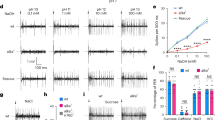Abstract
Micromolar concentrations of cycloheximide (CH) can be used to test for genetic differences in the ability to taste bitter substances. Three related strains of rats — Fawn-hooded, Long Evans, and Wistar — differ significantly in their ability to taste this substance, the former being unusually deficient in this respect. Wistar and Long Evans rats are able to perceive millimolar concentrations of phenylthiocarbamide (PTC) and 0.2 μM CH. FH animals are unable to detect millimolar PTC and first recognize CH when it is present in 1.5 μM concentration.
Similar content being viewed by others
References
Bellin, J. S., and Sorrentino, J. M. (1974). Kinetic characteristics of monoamine oxidase and serum cholinesterase in several related rat strains.Biochem. Genet. 11:309–312.
Booth, D. A., and Simson, P. C. (1973). Aversion to a cue acquired by its association with effects of an antibiotic in the rat.J. Comp. Physiol. Psychol. 84:319–323.
Fisher, R. A., Ford, E. B., and Huxley, J. A. (1939). Taste-testing the anthropoid apes.Nature 144:750–752.
Glaser, D. (1972). Untersuchungen über die Geschmakswirking von Phenylthiocarbamide (PTC) bei Primaten.Folia Primatol. 18:27–34.
Klein, T. W., and DeFries, J. C. (1970). Similar polymorphism of taste sensitivity to PTC in mice and man.Nature 225:555–557.
Kusano, T., Kasahara, Y., and Kawamura Y. (1971). A study on taste effectiveness of cycloheximide as a repellent to rats.Appl. Exptl. Zool. 6:40–50.
Levine, P., and Anderson, A. S. (1932). Observations on taste blindness.Science 75:495–498.
Omura, K., Takaji, S. F., and Harada, O. (1961). On the mechanism of the repellent action of naramycin to rats.Gunma J. Med. Sci. 10:217–227.
Richter, C. P., and Clisby, K. H. (1941). Phenylthiocarbamide taste thresholds of rats and human beings.Am. J. Physiol. 134:157–164.
Spuhler, J. N. (1967).Genetic Diversity and Human Behavior, Viking Fund Publications in Anthropology No. 45, New York.
Sunderland, E. (1966). The tasting of phenylthiocarbamide in selected populations in the United Kingdom.Eugen. Rev. 58:143–148.
Traub, R., DeWitt, J. B., Welch, J. F., and Newman, D. (1950). Toxicity and repellency to rats of actidione.J. Am. Pharm. Ass. Sci. Ed. 39:552–555.
Tschopp, T. B., and Zucker, M. B. (1972). Hereditary defect in platelet function in rats.Blood 40:217–226.
Vessell, E. S. (1969). Recent progress in pharmacogenetics.Advan. Pharmacol. Chemotherop. 7:1–52.
Wheatcroft, P. E. J., and Thornburn, C. C. (1972). Toxicity of the taste testing compound phenylthiocarbamide.Nature New Biol. 235:93–94.
Author information
Authors and Affiliations
Rights and permissions
About this article
Cite this article
Tobach, E., Bellin, J.S. & Das, D.K. Differences in bitter taste perception in three strains of rats. Behav Genet 4, 405–410 (1974). https://doi.org/10.1007/BF01066160
Received:
Issue Date:
DOI: https://doi.org/10.1007/BF01066160




